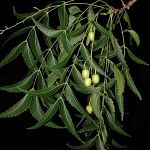| Common Name: |
Neem |
| Other Names: |
Nimba, Margosa |
| Botanical Name: |
Azadirachta indica syn. Melia azadirachta, M. indica |
| Genus: |
Azadirachta |
| Family: |
Meliaceae |
| Native Location: |
S Asia |
| Cultivation: |
Well-drained soil in sun. Tolerates poor soils and prolonged drought. |
| Propagation: |
By seed sown as soon as ripe. |
| Harvest: |
Leaves, flowers, bark and resin are collected as required and used fresh or dried in decoctions, infusions, medicated oils, powders, and pastes. Seeds are harvested when ripe for oil extraction. |
| Height: |
12-15m (40-50ft) |
| Width: |
12m (40ft) |
| Hardiness: |
Min. 15-18°C (59-64°F) |
| Parts Used: |
Leaves, flowers, bark, seeds, oil |
| Properties: |
A bitter, tonic herb that acts as an alterative, clearing toxins, reducing inflammation, lowering fever, promoting healing, and improving all functions. It destroys a wide range of parasitic organisms and is also insecticidal and spermicidal. |
| Medicinal Uses: |
Internally for malaria, tuberculosis, rheumatism, arthritis, jaundice, intestinal worms, and skin diseases. Not given to the weak, old, or very young. Externally for ringworm, eczema, lice, fungal infections, and painful joints and muscles. |
| Culinary Uses: |
Bitter leaves and flowers are added to appetizers, salads, and the Bengali dish shukto. Sap is fermented as alcoholic drink. Neem honey is produced in parts of Asia. |
| Economic Uses: |
Leaves are used in libraries and herbaria to protect against insect damage. Oil is used in hair dressings and insecticides (especially to protect crops against locust attack). Resin is added to soap, toothpaste, and skin lotions. |
| Bibliography: |
Encyclopedia of Herbs by Deni Brown Copyright © 1995, 2001 Dorling Kindersley Limited. pg 139 |

